| Diese Seite auf Deutsch! |
Snails and Slugs (Gastropoda) - An Introduction |
|
 |
||||||||||||||||||||||||||||||||
| Number of species in Mollusca, displayed by classes, including percentage. Sources: WoRMS: MolluscaBase eds. (2025): Mollusca LINNAEUS, 1758. | |||||||||||||||||||||||||||||||||
Everyone knows snails: Slowly crawling creatures, carrying a spiral shell on their back, or sometimes they don't, which makes them slugs. You meet them in gardens, forests, on walls, rocks, and occasionally even in the kitchen. But snails are much more than just slow garden visitors: they are one of the most successful groups of animals on Earth: According to various sources, there are about 65,000 to 80,000 species of snails, accounting for over 75% of all molluscs (see table above)!
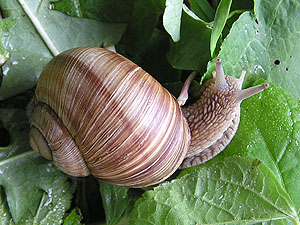 A Roman snail (Helix pomatia) is a terrestrial snail. Picture: Robert Nordsieck. |
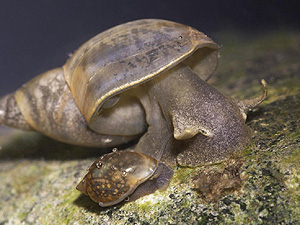 A pond snail (Lymnea stagnalis) and a bladder snail (Physella acuta) are fresh water snails. Picture: Lars Peters. |
 A whelk (Buccinum undatum), is a sea snail, also called a shell. Picture: Guido Schmitz (iNaturalist). |
|
Would You Have Known? A whelk is one of the few molluscs in the North Sea that actively hunts mussels. It does so by using its rasping tongue (radula) like a drill – a process that can last for hours but usually ends in death…
At least for the mussel...
|
In the sea to begin with, gastropods are found in a wide range of habitats: from rocky shores to coral reefs and even the mysterious hot vents of the deep sea. Some marine gastropods are colourful like exotic birds; others are so bizarre in appearance that one can hardly believe them to be snails at all. Their vibrant colours are often the result of camouflage being less important in the marine environment. There are notable exceptions, though: Limpets (Patellidae), for example, are superbly camouflaged by algal growth and sometimes barely recognisable as snails.
Whelks (Buccinidae), on the other hand, are
predatory marine gastropods hunting oysters and other bivalves on the ocean floor.
They use their radula to bore into their prey and feed on the soft tissue
within. Whelks also use their muscular foot to prevent the shell valves of the
bivalve from closing.
Freshwater habitats are also home to a great variety of snail species: The great pond snail (Lymnaea stagnalis), for example, is a familiar sight in garden ponds (hence the name). Unlike its voracious relatives in the vegetable patch, it is a peaceful aquatic creature and only rarely causes harm. Other freshwater snails, such as the New Zealand mud snail (Potamopyrgus antipodarum), are important bioindicators: when this species is the only one present in a water body, it is often a sign of nutrient pollution and a severely reduced aquatic community.
On land, the air-breathing land snails (Stylommatophora) have evolved an impressive diversity of forms: Snails are found in nearly all terrestrial habitats – as long as those are not too dry. Another key factor is the type of soil: many species prefer calcareous ground, which provides both building material for their shells and a habitat rich in nutrients and vegetation, as well as vital shelter.
People walking through nature with open eyes can observe snails almost everywhere: on the bark of trees, under logs, in shrubs, on walls, and, of course, in gardens.
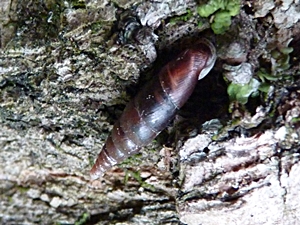 Smooth door snail (Cochlodina laminata) from the Vienna woods. Picture: Martina Eleveld. |
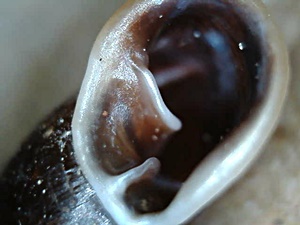 Aperture of Cochlodina laminata. Picture: Martina Eleveld. |
However, door snails can also be found in Central Europe, where they graze on algae growing on walls, rocks, and tree trunks. Most species are only a few centimetres (usually less than an inch) long, so a sharp eye is needed to spot them.
![]() Door Snails (Clausiliidae).
Door Snails (Clausiliidae).
![]() Hartmut Nordsieck on hnords.de: "The Science of Door Snails".
Hartmut Nordsieck on hnords.de: "The Science of Door Snails".
 Roman snail (Helix pomatia). Picture: Iris Eleveld. |
|
|
The "Spanish" Slug? The Spanish slug, or more accurately called the Lusitanian (i.e. Portuguese) slug was formerly known as Arion lusitanicus, because it was belie- ved to have originated on the Iberian Peninsula and to have been introduced to Europe by man. In the meantime, however, it has been found out that Arion lusitanicus still exists in its original dis- tribution area and that it is not the same species as the large brown slug encountered in Central Europe and other parts of the world. So that spe- cies today is called Arion vulgaris, the common slug, true to its name. Where it came from is still not well known. |
It is one of the few
snail species still farmed and commercially used today.
![]() Terrestrial Snails.
Terrestrial Snails.
![]() Heliciculture: Raising Snails.
Heliciculture: Raising Snails.
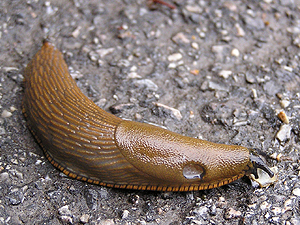 Spanische Wegschnecke (Arion vulgaris) aus Wien. Bild: Robert Nordsieck. |
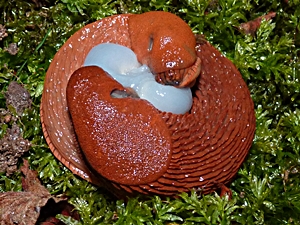 Paarung der Spanischen Wegschnecke (Arion vulgaris). Bild: Martina Eleveld. |
Often, the damage done by such pests is exacerbated when slugs no longer die off during winter as they usually would, resulting in doubled populations the following year.
Elsewhere in the world, other snail and slug species have also become agricultural pests, particularly when introduced in areas lacking natural predators. One example is the East African giant land snail (Lissachatina fulica), which in some places is bred as a food source. The species is also often kept as a terrarium snail but escaped from captivity and was able to establish wild populations outside of its natural area of distribution. In several parts of the United States, the species is considered a very harmful agrarian pests and is forbidden to be transported across state borders.
On the other hand, the rosy wolfsnail (Euglandina rosea) was deliberately introduced to several Polynesian islands in an attempt to control the invasive giant African land snails. Unfortunately, however, the wolfsnail preferred to hunt down the small native Partula snails (Partulidae). Since those species often were endemic to certain islands, many of them have since become virtually extinct in the wild and now survive only in conservation programmes and zoological collections.
Not all snails and slugs, however, are pests - quite the opposite actually: in nature, many species play a vital ecological role, since they are an important food source for many animals, such as hedgehogs, toads and birds. People who use poisonous snail pellets in the garden often unintentionally also harm those helpful animals, since the poison accumulates in their organisms. Also, snails and slugs consume decaying organic matter, and, like earthworms, contribute to soil formation by breaking down organic material and mixing it with the mineral components of the soil.
In doing so, they assist in producing compost, which is why many of them are often found in compost heaps. So some slugs can even be beneficial in gardens: for example, the so-called keelback slugs (Limacidae). One of them, the leopard slug (Limax maximus), not only feeds on decaying matter and mushrooms, but is also known to eat other slugs and their eggs. And, like other snails, it is also often found in compost heaps. It does, however, typically occur in relatively low numbers, so its contribution to controlling pest slugs like Arion vulgaris is limited. Sadly, it also often falls victim to the general persecution of all slugs.
![]() Snails and Slugs in the Garden.
Snails and Slugs in the Garden.
![]() Keelback Slugs
(Limacidae).
Keelback Slugs
(Limacidae).
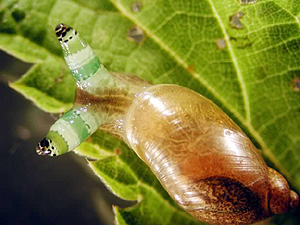 An amber snail (Succinea putris) infected by Leucochloridium spec. Picture: Christian Fuchs. |
 The lesser pond snail (Galba truncatula) is an intermediate host for the liver fluke (Fasciola hepatica). Picture: © Alexander Mrkvicka, Vienna. |
One particularly striking example is Leucochloridium paradoxum, a parasitic fluke whose larvae invade the tentacles of certain amber snails (e.g. Succinea putris). There they form pulsating, greenish-striped "sporocysts" that resemble caterpillars. Infected snails display abnormal behaviour, leaving their hiding places in the shade and climbing into exposed positions – making them an easy target for birds, the parasite’s final host. That way, the parasite completes its complex life cycle.
But birds are not the only ones affected. In tropical regions, freshwater snails, such as the Planorbid snail Biomphalaria glabrata, transmit the larvae of blood flukes (Schistosoma mansoni), the infective agent of schistosomiasis (also known as bilharzia) – a serious parasitic disease that affects millions of people every year.
![]() Distribution of Bilharzia (Schistosomiasis) worldwide (New Window).
Source:
WHO (Wikipedia).
Distribution of Bilharzia (Schistosomiasis) worldwide (New Window).
Source:
WHO (Wikipedia).
In Europe, other parasitic infections are more common, such as Fasciolosis, caused by the large liver fluke (Fasciola hepatica), affecting grazing livestock, or lungworms that can infect dogs and cats. Intermediate hosts for these parasites include aquatic snails such as the lesser pond snail (Galba truncatula).
![]() Large Liver Fluke (Fasciola hepatica).
Large Liver Fluke (Fasciola hepatica).
Contrary to that, the intermediate hosts of the lancet liver fluke (Dicrocoelium lanceolatum) are often land snails that prefer warm or dry habitats, such as heath snails (Helicella spp.) or the zebra snail (Zebrina detrita).
![]() Lancet Liver Fluke (Dicrocoelium
lanceolatum).
Lancet Liver Fluke (Dicrocoelium
lanceolatum).
For humans in Central Europe, the risk of infection today is usually very low – nevertheless, snails clearly play an important and often underestimated role from a medical perspective as well.
![]() Parasites: Snails as intermediate hosts.
Parasites: Snails as intermediate hosts.
 A snail farm in Elgg (Switzerland). Picture: Robert Nordsieck. |
 Ulm box boat near Kellheim (Danube). Copper engraving (1839). |
In Eastern and Southeastern Europe, as well as in Turkey, edible snails are still collected in the wild on a large scale – in Turkey, this often includes the Turkish banded snail (Helix lucorum). In parts of Central Europe, Helix pomatia has become rare due to overharvesting, especially in the years following World War II, and is now protected by law.
Historically, snails were also kept in so-called "snail gardens", which often were part of a monastery. Since snails were not considered meat, their consumption was permitted during Lent under the dietary rules of the time.
A historical centre of snail farming in Germany is the Lauter Valley on the Swabian Jura in the Southwest German state of Baden-Württemberg, where the calcareous soils provide excellent conditions for snails. From there, the snails were transported to the city of Ulm and loaded onto special boats known as Ulm box boats (Ulmer Schachteln). These boats carried them down the Danube, supplying monasteries along the river – and even reaching as far as Vienna, where the Swabians sold their goods at local markets and supplied the Habsburg court.
![]() Heliciculture:
Economic Snail Farming.
Heliciculture:
Economic Snail Farming.
![]() Albschneckler:
Snail Cultivation in the Lauter Valley (in German).
Albschneckler:
Snail Cultivation in the Lauter Valley (in German).
![]() Gugumuck.com: Vienna Snail Manufacture: Snail farm in Rothneusiedl near
Vienna.
Gugumuck.com: Vienna Snail Manufacture: Snail farm in Rothneusiedl near
Vienna.
It is well visible that the shell has an top (left) and a bottom side (centre), because it is coiled asymmetrically, even if that appears not to be the case. |
|
Morphology - What is That? In biology, the field concerned with the structure and function of an organism’s body parts and organs is called  In general, as on this page, the distinction is to be made between the external and internal morphology of a snail. While the external morphology can be studied by observing the living animal, the internal morphology requires the snail to be euthanised and dissected. This makes it difficult to observe how the organs function in a living specimen. |
Nonetheless, snails can be clearly distinguished from other molluscs: Unlike bivalves, snails have a distinct head with sensory tentacles. The most important feature, however, is their single, spirally coiled shell, which sets them apart from bivalves with their two hinged shell valves.
In contrast to the shell of cephalopods – such as the nautilus, a so-called living fossil, or the true fossil ammonites – the shell of a snail is asymmetrically coiled to one side as a result of a developmental process called torsion.
In some snails, such as the cheese snail (Helicodonta obvoluta) native to Central Europe or the aquatic ramshorn snails (Planorbidae), this asymmetry is not necessarily immediately obvious. However, every snail shell has a distinguishable top and bottom side (see image on the left).
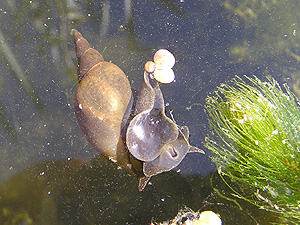 A pond snail (Lymnaea stagnalis) crawling at the water sur- face. Picture: Robert Nordsieck. |
|
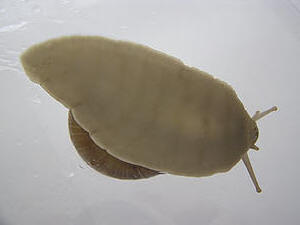 Bottom side of a crawling Roman snail. The darker transver- sal stripes are wave-like motions of the foot-sole, which the snail moves by. Left behind the snail is the conspicuous slime trail. Picture: Robert Nordsieck. |
But not all snail feet are the same: Depending on their habitat and way of life, the form and function of the foot have adapted significantly:
Many slugs, such as species of Arion and Deroceras, retreat into the soil during dry periods to avoid desiccation. Without the protection of a shell, this behaviour is essential for survival. Some predatory slugs, like the so-called "rucksack snails" (Daudebardiidae or Testacellidae), use their slender bodies and powerful foot to hunt earthworms underground – leading an almost completely subterranean lifestyle. Another slug, the Welsh ghost slug (Selenochlamys ysbryda), lives nearly its entire life below ground and was therefore only discovered very recently.
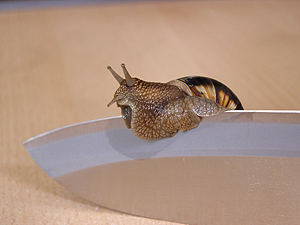 Turkish striped Helix (Helix lucorum) crawling over a knife blade. Picture: Robert Nordsieck. |
![]() Picture Series: Turkish striped Helix (Helix lucorum) crawling over a knife blade.
Picture Series: Turkish striped Helix (Helix lucorum) crawling over a knife blade.
Some marine snails, like the queen conch (Aliger gigas), use their sickle-shaped operculum (a rigid plate that closes the shell opening) like a lever to hurl themselves from the seabed in a jerking motion. This unusual "jumping" technique serves as a way to escape predators, but has also earned the species the nickname "fighting conch", since they use its sharp edge to defend against predators.
The Canadian jumping slugs (Hemphillia dromedarius) also use sudden contractions of their foot to rapidly dart away when threatened.
Tree-dwelling snails such as Amphidromus inversus or certain tropical amber snails (Succineidae) possess especially adhesive feet that allow them to crawl along smooth surfaces – often even upside-down on the undersides of leaves. Many other kinds of snails, such as banded snails (Cepaea) or door snails (Clausiliidae), are also excellent climbers.
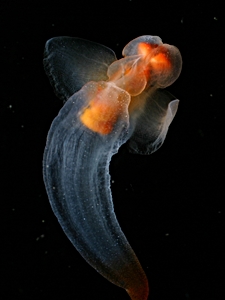 Clione limacina, Clionidae. Arctic Sea. Picture: Kevin Raskoff: (Source). |
Terrestrial slugs like the leopard slug (Limax maximus) often possess a relatively broad foot, which increases the surface area for adhesion – especially useful when crawling up vertical surfaces or abseiling on mucus threads, as observed during their elaborate mating rituals. Other slugs, such as the common Arionidae or Agriolimacidae, also use this mucus-assisted "abseiling" behaviour to descend from elevated positions.
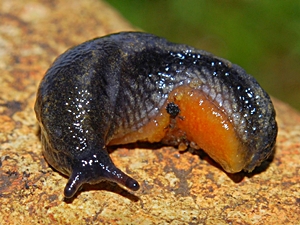 Garden slug (Arion hortensis) from England. Picture: Brian Eversham: (Source). |
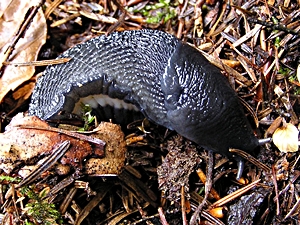 Foot sole of a black keelback slug (Limax cinereoniger) with characterical longitudinal stripes. Picture: Robert Nordsieck. |
In molluscs, the body parts are less distinctly separated than in segmented animals such as arthropods. In snails, the head and foot are therefore sometimes collectively referred to as the cephalopodium ("head-foot"). The head serves as the centre of perception and orientation – clearly distinguishing snails from bivalves, which do not possess a head at all.
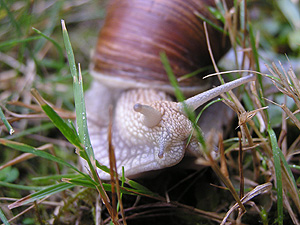 The head of a Roman snail (Helix pomatia) with its characte- ristic four tentacles. Picture: Robert Nordsieck. |
All snails possess at least one pair of tentacles. The largest and most diverse group, the land snails (Stylommatophora), has two pairs of tentacles, arranged one pair above the other, each with its own retractor muscles. The upper (longer) tentacles bear an eye at the tip, giving this group its name: Stylommatophora – "stalked eye bearers". In contrast, fresh water pulmonate snails (Hygrophila) have only a single, non-retractable tentacle pair, with eyes located at the base.
 Roman snail (Helix pomatia) extending one of its tentacles. Video: Martina Eleveld. |
Above the mouth are the oral lobes, which also bear chemosensory receptors for close-range orientation. These allow snails to follow or avoid the slime trails of other snails. In some carnivorous land snails, such as the tropical rosy wolf snail (Euglandina rosea), these lobes are elongated and tentacle-like. This species uses them to track down prey by following their slime trails.
Some sea slugs, such as sea hares (Aplysiomorpha) or nudibranchs (Nudibranchia), possess an additional pair of specialised olfactory tentacles called rhinophores.
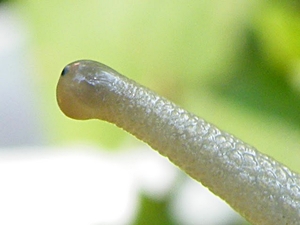 Eye stalk of a Roman snail. Picture: Martina Eleveld. |
Unlike in vertebrates, snails' photoreceptors face inwards – a fundamentally different evolutionary and developmental path. Even the more advanced lens eyes of the Roman snail allow only the perception of light, shadow, and movement. They cannot perceive colour or sharp details.
Not all sensory functions are restricted to the head. Other parts of the body – especially the foot – are equipped with cells that, for instance, detect light and shadow. Many snails respond to sudden darkness with a "shadow reflex": when a shadow falls over them, they quickly retract into their shell – a simple yet effective defence against predators. Sensory cells on the foot also allow snails to sense moisture and temperature – an ability especially important for land snails.
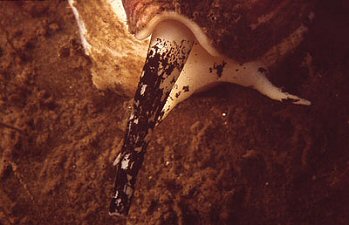 A whelk (Buccinum undatum), searching for prey using its osphradium. The long sipho is used for orientation. Picture: Peter Jonas, Underwater World Baltic Sea. |
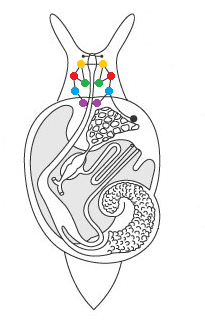 |
![]() Image right: Nervous system of a pulmonate snail. Positions of
various ganglia in the body. Yellow: cerebral ganglia. Red: pleural ganglia.
Green: pedal ganglia. Blue: parietal ganglia. Violet: visceral ganglion. This
arrangement already represents a high degree of centralisation – in other snail
groups, ganglia may be more widely distributed. (Source: KAESTNER, A.:
Lehrbuch der Speziellen Zoologie. Gustav Fischer, 1996, modified.
Image right: Nervous system of a pulmonate snail. Positions of
various ganglia in the body. Yellow: cerebral ganglia. Red: pleural ganglia.
Green: pedal ganglia. Blue: parietal ganglia. Violet: visceral ganglion. This
arrangement already represents a high degree of centralisation – in other snail
groups, ganglia may be more widely distributed. (Source: KAESTNER, A.:
Lehrbuch der Speziellen Zoologie. Gustav Fischer, 1996, modified.
A large part of a snail’s internal organs is located in the visceral mass – a dorsal extension of the foot. The visceral mass or visceral sack is then protected by a tough layer of skin called the mantle (pallium). In addition to its protective role, the mantle has another vital function: cells in its surface secrete calcium carbonate, which is used to form and repair the shell, which characteristically most snails possess.
In some gastropod groups, the shell has been reduced over the course of evolution to increase mobility: In those shell-less snails usually referred to as slugs, such as the Spanish slug (Arion vulgaris), the mantle and also the especially viscous body mucus take over the absent shell's protective functions.
Inside the mantle there is the mantle cavity, which houses the respiratory organs. In many aquatic snails, these are gills. In contrast, pulmonate snails have developed the mantle cavity into a simple lung, whose well-vascularised wall allows for the uptake of oxygen from the air.
 Torsion in different snail groups: a) Prosobranch; b) Intermediate stage; c) Opisthobranch; d) Pulmonate. (Note: This terminology is systematically obsolete!). Source: Urania Tierleben, Wirbellose 1 (1996). |

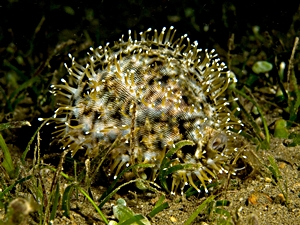 Left: Cowry shell (Cypraeidae), X-Ray image (Picture: Michel Royon). Right: Living tiger cow- ry (Cypraea tigris). (Picture: Nick Hobgood). The shell spire is only visible, when the shell is sawed open or observed via x-ray imaging! (Source: Wikipedia). |
This is why snail shells are asymmetrical, coiled either to the right or the left – unlike, for instance, the concentrically coiled shell of the Nautilus, one of the few modern-day (recent or extant) shelled cephalopods. The direction of coiling can have systematic relevance in some snail species (see below).
The basic vertical structure of a snail shell is made up of an organic outer layer (periostracum) and a mostly calcareous internal layer (ostracum). The robustness of snails' shells varies greatly: the thick, solid shells of helmet snails (Cassidae), for example, are so strong that they have inspired engineers to design new composite materials. Other groups, such as the terrestrial glass snails (Vitrinidae), have gradually reduced their shells in favour of increased mobility – a process known as vitrinisation.
Although the shell is not actually part of the snail’s body, since it is secreted by the mantle, it is, however, firmly connected to the body via the columellar muscle (also called the main retractor muscle): This muscle is attached to the inner columella of the shell and enables many snails to retract completely into their shells. Losing the shell would therefore be fatal to any snail. Retraction into the shell, often combined with a closing operculum (see below), provides protection from predators – and for land-dwelling species, also protection from desiccation and cold.
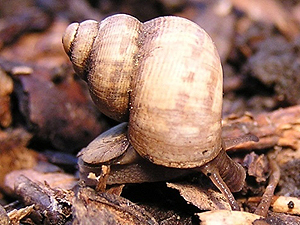 A round-mouthed snail (Pomatias elegans), with its shell lid (Operculum). Picture: Michael Stemmer. |
Many snails – including most aquatic snails and even some land-dwelling species such as land operculates – possess a horny or calcareous lid, known as the operculum, which they use to close off the opening (aperture) of their shell.
 Danube river snail (Viviparus acerosus). Picture: © Alexander Mrkvicka, Vienna. |
In some species, the operculum even serves additional functions, such as aiding in locomotion or defence. The queen conch (Aliger gigas, see above), for instance, is sometimes referred to as a "fighting conch", since it uses its sickle-shaped operculum not only to push itself off the sea floor in a sudden leap, but also to defend itself by striking at attackers.
In other species, such as the turban snails (Turbinidae), the porcelain-like, glossy opercula – also known as Shiva’s eyes – are used as ornamental stones or charms, with larger ones even sold as paperweights. In some cultures of the Middle East and East Asia, opercula from various marine snails are also used as ingredients in incense.
In contrast to this operculum, which is firmly attached to the foot, stands the temporary calcareous lid formed by snails such as the Roman snail (Helix pomatia) during hibernation. This so-called epiphragm is not connected to the body and is shed by the snail at the end of hibernation.
![]() The Hibernation of
Roman Snails (Helix
pomatia).
The Hibernation of
Roman Snails (Helix
pomatia).
What causes revulsion in many people is essential for a snail’s survival: their mucus. This versatile secretion is made up mostly of water, but its consistency and function can be fine-tuned through the addition of certain proteins (mucins and mucopolysaccharides) and other molecules – depending on its purpose and application.
The mucus covering the entire body of a land snail protects it from desiccation and also acts as a lubricant. In some species, like the Roman snail (Helix pomatia), a particularly foamy defensive mucus can be produced in dangerous situations. This so-called "bubble slime" is thick and sticky – and can deter predators such as ants.
 "Hopping" Cornu aspersum (see text). Picture: Robert Nordsieck. |
|
 The head of a rosy wolfsnail (Euglandina rosea). Source: CABI Digital Library. |

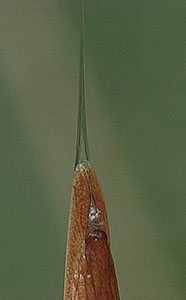 A slug (Arionidae) "abseiling" on its own slime thread. Right: Detail View. Pictures: Andreas Heidl. |
To reduce water loss through their pedal mucus, snails such as the brown garden snail (Cornu aspersum) often move in a "hopping" gait, where only parts of the sole are in contact with the substrate. Aquatic snails like those in the family Lymnaeidae can even crawl upside down on the water surface, using their mucus to cling to the surface tension (see image above).
But mucus is not just for crawling: some land slugs, such as the leopard slug (Limax maximus), produce a mucus thread which they can use to lower themserlves from elevated positions. The leopard slug even employs this trick during its spectacular mating ritual.
![]() Picture series:
Die Paarung des Tigerschnegels
(
Picture series:
Die Paarung des Tigerschnegels
(![]() Playlist on our
YouTube Channel; in German).
Playlist on our
YouTube Channel; in German).
Roman snails (Helix pomatia) can enrich their pedal mucus with carbon dioxide, making it slightly acidic and enabling them to dissolve calcium from the substrate. Some species, such as the Sicilian garden snail (Cornu mazzullii), even use this ability – in combination with shell movements – to carve out small cavities in limestone. In other, predatory snails like the Dalmatian carnivorous snail (Poiretia cornea), the mucus contains litholytic substances, which soften or dissolve the shells of their prey. This allows them to break through shells not by force, but by chemistry, before bringing the radula into play.
These are not the only important chemical properties of snail mucus. Snails can even identify one another via their slime trails. For instance, Roman snails tend to avoid crossing the trails of other individuals – an effective way to prevent overpopulation in a shared habitat. Predatory snails like the rosy wolfsnail (Euglandina rosea), on the other hand, track their prey – usually other snails – by following their mucus trails. The greatly elongated oral lobes of this species, which contain olfactory receptors, resemble a third pair of tentacles and are highly adapted to this purpose.
And it’s not just snails who benefit from the chemical properties of snail slime: the cosmetics industry has also found uses for the beneficial compounds found in snail mucus (see also: Heliciculture - Economic Snail Farming).
A
particularly unusual mode of locomotion is found in the pelagic
violet sea snail
(Janthina janthina): it creates a raft of air bubbles coated in mucus, which it
hangs from while drifting with ocean currents. This floating strategy allows it
to encounter prey animals – typically jellyfish – which likewise float at the
ocean surface.
|
YouTube Video: Black keelback slug (Limax cinereoniger) feeding on a mushroom. Video by Martina Eleveld. |
Rock-dwelling limpets (Patellidae), which graze algae off hard surfaces, have a rigid, beam-shaped radula with numerous broad teeth – a perfect biological rasp. Their relatives in the group Patellogastropoda were therefore historically referred to as Docoglossa, or "beam-tongue snails".
Among terrestrial snails, the shape of the radula teeth can also reveal their diet:
![]() The Nutrition of Snails (3 Parts).
The Nutrition of Snails (3 Parts).
![]() Wikipedia:
Radula.
Wikipedia:
Radula.
Reproductive strategies among snails are nearly as diverse as the group itself. While many marine snails undergo a complex life cycle with free-swimming trochophore and veliger larvae, land snails usually lay their eggs in protected places – and from these eggs, fully developed juveniles hatch. These juveniles carry a small shell with just a few whorls, which continues to grow along with the animal until it reaches sexual maturity.
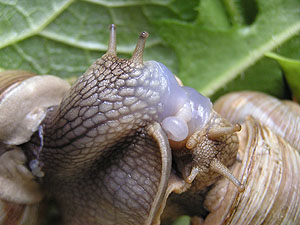 Roman snails mating. Picture: Robert Nordsieck. |
 Behind the left tentacle of this river snail, there is the sipho, through which water enters and leaves the pallial cavity. The right tentacle in the background serves as a copulatory or- gan, so this specimen is a male. Picture: © Alexander Mrkvicka, Vienna. |
![]() Reproduction of the
Roman Snail.
Reproduction of the
Roman Snail.![]() New Zealand Mud Snail (Potamopyrgus antipodarum): Life Cycle
(Wikipedia).
New Zealand Mud Snail (Potamopyrgus antipodarum): Life Cycle
(Wikipedia).
In contrast, among the aquatic "prosobranch" snails (a now outdated taxonomic term), most species are dioecious, i.e. have separate sexes. For example, in the river snail (Viviparus contectus), males and females can be distinguished by shell shape, and males also modify one of their tentacles into a copulatory organ, which is externally visible.
Snails possess a highly specialised reproductive system, which is often used for species identification, especially in groups with similar shell morphology. The complex structure of the reproductive organs in the Roman snail (Helix pomatia) is described in detail on a separate page.
![]() Genital Apparatus Anatomy of the Roman snail (Helix pomatia).
Genital Apparatus Anatomy of the Roman snail (Helix pomatia).
![]() Genital Apparatus Terminology in Clausiliidae (hnords.de).
Genital Apparatus Terminology in Clausiliidae (hnords.de).
Some snail species have developed remarkably elaborate courtship behaviour: in Helix pomatia and other helicid snails, for example, the partners shoot a love dart made of calcium carbonate into each other’s bodies. This sharp dart, covered in hormone-rich mucus, is assumed to increase the chances of successful fertilisation for the dart-shooting individual.
![]() Reproduction of Helicid Snails:
The Love Dart.
Reproduction of Helicid Snails:
The Love Dart.
The spectacular aerial mating procedure of the leopard slug (Limax maximus), which hangs from a slime thread during copulation, was famously documented by David Attenborough in the BBC series "Life in the Undergrowth".
![]() Leopard Slugs Mating
(Picture Series).
Leopard Slugs Mating
(Picture Series).![]() Playlist on our
YouTube Channel (in German).
Playlist on our
YouTube Channel (in German).
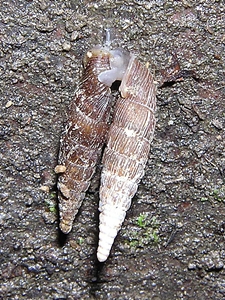 Common door snail (Alinda biplicata) mating. Picture: Robert Nordsieck. |
While most snails lay eggs, there are exceptions: some species, such as certain river snails (Viviparidae) or door snails (Clausiliidae), give birth to fully developed live young – a phenomenon known as ovoviviparity.
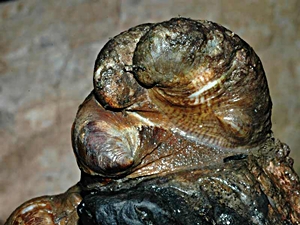 Slipper limpets (Crepidula fornicata) mating. Picture: Keith Hiscock, Marine Life Network. |
![]() Literature:
Hybridisation in Door Snails (Clausiliidae), after: NORDSIECK,
H. (2022): "European Door Snails (Clausiliidae) I", Kap. 8, S. 156 ff.
Literature:
Hybridisation in Door Snails (Clausiliidae), after: NORDSIECK,
H. (2022): "European Door Snails (Clausiliidae) I", Kap. 8, S. 156 ff.
Inter-species mating has also been observed between different genera of helicid snails (e.g. Helix and Cepaea, or Cornu and Cepaea), albeit those do not result in hybrids: This is likely due to the semi-specific nature of chemical signals used to attract mates, which can sometimes lead to unsuccessful mating attempts between different species, without producing offspring.
![]() Inter-Species Mating
between Helix and Cepaea.
Inter-Species Mating
between Helix and Cepaea.![]() Snail Reproduction:
Additional Information.
Snail Reproduction:
Additional Information.
The special zoology discipline concerned with gastropods and other molluscs is called malacology (from Ancient Greek μαλακός (malakós), meaning "soft"). Its main objectives include not only the study of the incredible diversity and adaptability of molluscs, but also the development of a logical classification system that groups all known species according to their ancestry and evolutionary relationships. In short: systematics is the attempt to trace the red thread of evolution through the chaos of forms.

 Carl v. Linné and the title page of his most famous work, the Sys- tem of Nature (Systema Naturae, 10. Ed, 1758). Source: Wikipedia. |
So, for example, the species formerly known as Helix aspersa is now referred to as Cornu aspersum – a prime example of the dynamic nature of this field.
The scientific name of a snail species always consists of a capitalised genus name, a lowercase species name, the name of the author who first described it, and the year when he did. All scientific names are latinised, but might be derived from Greek or from other languages. In the case of the well-known Roman snail, for instance: Helix pomatia Linnaeus, 1758 – Helix as the genus, pomatia as the species, and Linnaeus as the authority. 1758 was the year Linné's famous Systema Naturae was published.
![]() "Latin" names in Systematics: Why are systematic names so complicated?
"Latin" names in Systematics: Why are systematic names so complicated?
A closely related species is the Turkish striped Helix, Helix lucorum, also belonging to the genus Helix. Another example is the fossil clausiliid Macrogastra (Macrogastra) reischuetzi H. Nordsieck, 2014, from the Miocene of Lower Austria – here, the subgenus is given in parentheses, along with the year of the subspecies’ description. Also the scientist's name is given with initials to discern him from other scientist of the same name.
For a long time, snails were roughly divided into three major groups: gill-breathers with forward-positioned gills ("Prosobranchia"), those with gills at the rear (“Opisthobranchia”), and lung-breathers ("Pulmonata"). However, modern genetic analyses reveal that evolutionary relationships are far more complex. Today, groupings such as the Euthyneura ("straight-nerved"), which include both opisthobranchs and pulmonates, are considered to form more natural (monophyletic) lineages.
|
Source: SWF Beach Life on YouTube. |
In addition to large state-run natural history museums – with the Senckenberg Museum in Frankfurt and the Natural History Museum in Vienna being among the most renowned in the German-speaking world – there are also private museums: The largest private shell collection in Germany can be found at the Haus der Natur (“House of Nature”), a privately run natural history museum in Cismar, East Holstein.
In the United States, there obviously is but one museum exclusively dedicated to shells and their research: The Bailey Shell Museum and Aquarium in Sanibel, Florida. But of course there are departments of malacology and malacological collections in almost every major Natural History Museum in the world.
![]() Senckenberg-Museum Frankfurt: Sektion Malakologie.
Senckenberg-Museum Frankfurt: Sektion Malakologie.
![]() Naturhistorisches Museum Wien: 3. Abt. Zoologie: Sammlung Mollusca.
Naturhistorisches Museum Wien: 3. Abt. Zoologie: Sammlung Mollusca.
![]() Museum Haus der Natur, Cismar,
Ostholstein.
Museum Haus der Natur, Cismar,
Ostholstein.![]() Bailey Shell Museum and Aquarium, Sanibel, Florida, USA.
Bailey Shell Museum and Aquarium, Sanibel, Florida, USA.
Many amateur enthusiasts also collect or trade snail shells. Some specimens can fetch high prices depending on their rarity – such as the cone shell Conus gloriamaris, which at one time was sold for several thousand dollars. Since its rediscovery in 1969, however, its price has dropped to around 100 dollars. On the other hand, many marine snail species are now threatened not only by environmental changes but also by overharvesting for the shell trade.
![]() More about conchology
(Coming soon!).
More about conchology
(Coming soon!).![]() Club Conchylia e.V.:
German Shell Collectors.
Club Conchylia e.V.:
German Shell Collectors.
![]() Conchology.be:
Shell trading with scientific expertise.
Conchology.be:
Shell trading with scientific expertise.
![]() SWF BeachLife: Southwest Florida Seashells on
YouTube.
SWF BeachLife: Southwest Florida Seashells on
YouTube.
![]() Marcus
Coltro:
Paris Shell Show 2022.
Marcus
Coltro:
Paris Shell Show 2022.
Interested in more?
This introduction is only the beginning. Get to know more about the astonishing diversity of snails and other gastropods
– from their role in science and research unto their place in Art, Kitchen and Culture:
![]() Snails in Research (Coming soon!).
Snails in Research (Coming soon!).![]() Snails in Culture (Coming soon!).
Snails in Culture (Coming soon!).
Latest Change:
20.06.2025 (Robert
Nordsieck).